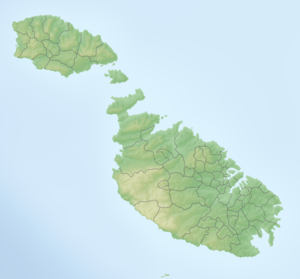St Mary's Tower
| St Mary's Tower | ||
|---|---|---|
|
St Mary's Tower |
||
| Alternative name (s): | Comino Tower | |
| Creation time : | 1618 | |
| Conservation status: | restored (2002-2004) | |
| Construction: | Limestone - masonry | |
| Place: | Comino | |
| Geographical location | 36 ° 0 '25 " N , 14 ° 19' 47" E | |
|
|
||
The St Mary's Tower , due to its location and Comino Tower called, is one during the reign of the Order of St. John , built in 1618 fort on Malta . The tower stands on the between the islands of Malta and Gozo in Gozokanal nearby island of Comino . The tower is one of a series of six fortifications built during the reign of Grand Master Alof de Wignacourt from 1609 to 1620, known as the Wignacourt Towers . It is included in the National Inventory of the Cultural Assets of the Maltese Islands .
prehistory
Due to its location, the island of Comino controls the Gozo Canal and thus also the shipping traffic between the main island and Gozo. The bays of the island, but also the bays in the northern part of the main island, were used by corsairs to hide their ships. From these positions, they repeatedly attacked shipping around Malta. Despite its importance, the island had remained unfortified for a long time. It was not until 1618 that the resources of the order made it possible to build a fortification on Gozo.
Building and construction
The tower is occasionally attributed to the Maltese architect Vittorio Cassar . Since Cassar probably died in 1607, this is unlikely. Because of the isolated location, which complicated the construction, the construction costs were higher than for the other towers built during this period. The tower should also be able to withstand a siege for a long time, as it was difficult to bring reserves to Comino. Therefore it was made more massive than the other towers. This also made the construction more expensive. The cost ended up being 18,628 scudi .
The tower has a square floor plan and four corner towers. The corner towers are designed as half bastions . However, the flanks of these bastions were very narrow. The base of the curtain was also in line with that of the towers. This reduced the effectiveness of the flanking fire. The entire tower stands on a mighty, square base, which, like the tower, was made of limestone. The six-meter-thick walls of the construction left space for only one small room on each floor, vaulted with a barrel vault. The entrance was at the rear of the tower and led to the ground floor. Access was via stairs and a drawbridge. The flat roof with a parapet was accessed via stairs inside the tower.
The tower was originally equipped with ten larger and six smaller cannons. The peacetime crew consisted of sixteen soldiers.
Signals were also sent from the platform about twenty meters above the ground. During the day this was done by firing one of the cannons, at night by a beacon. The garrisons on Gozo and Malta could be alerted via a signal chain made up of towers. From the tower there is a direct line of sight to the Mġarr ix-Xini Tower on Gozo and to St Agatha's Tower and the Aħrax (White) Tower on Malta.
Extensions in the 18th century
From 1710 the existing towers were adapted to the requirements of modern warfare. Numerous towers received batteries in front , which were constructed according to a uniform scheme. Such a semicircular battery was also installed immediately in front of St Mary's Tower, with space for seven guns. A log house was built in the center of the battery as accommodation and storage room.
French rule
During the French occupation of the islands, the tower was initially used as a prison. With the beginning of the uprising against the French occupiers, the guns of the tower and the battery were expanded and used in field fortifications, from which the French troops were shelled in Valletta .
British colonial rule
At the beginning of British colonial rule, the tower was initially continued to be used. Plans from 1813 for expansion were not implemented. In 1828 the demolition of all towers, redoubts and batteries built by the knights was proposed and ordered in 1832, but St Mary's Tower remained. Like the other towers that are no longer in use, it was handed over to the local authorities.
The tower has been used by the Armed Forces of Malta since the end of British colonial rule .
literature
- Quentin Hughes : Malta. A guide to the fortifications , Said International, 1993. ISBN 9990943 07 9
- Stephen C. Spiteri : The Knight's Fortifications: an Illustrated Guide of the Fortifications built by the Knights of St. John in Malta , Book distributors limited, 2001. ISBN 9789990972061
- Charles Stephenson: The Fortifications of Malta 1530-1945 , Osprey Publishing Limited, 2004, ISBN 1-84176-836-7
Web links
- Stephen C. Spiteri: Sta. Maria Tower on Comino (English)
- Santa Marija Tower, Comino , Din l-Art Ħelwa, October 6, 2011 (English)



